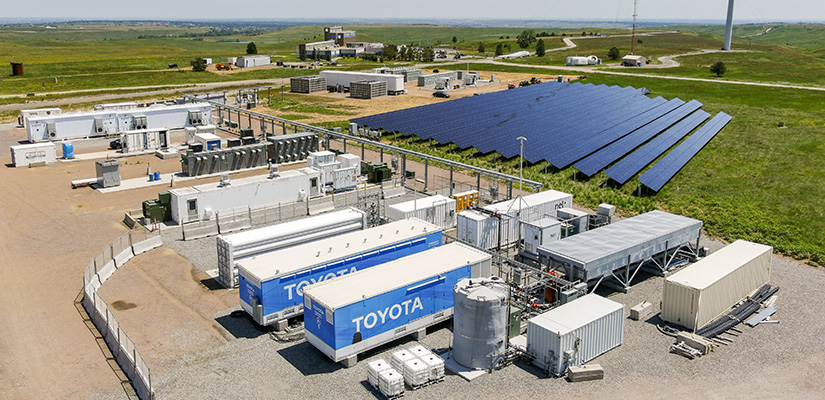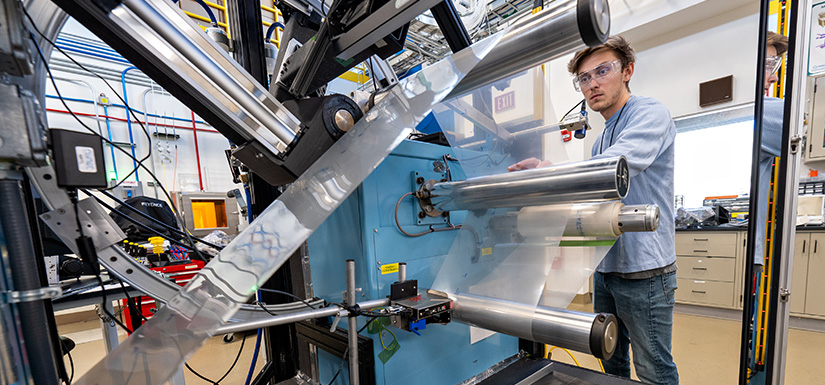For National Hydrogen and Fuel Cell Day, NREL Spotlights Innovations To Make, Move, Store, and Use Hydrogen
NREL’s Hydrogen and Fuel Cell Research Is Unlocking the Energy Potential of Hydrogen

October 8 (10.08) is national hydrogen and fuel cell day—a nod to the atomic weight of the most abundant element in the universe: 1.008.
This year, the National Renewable Energy Laboratory (NREL) marks the occasion by spotlighting its hydrogen and fuel cell research, which is lowering the cost and increasing the scale of technologies to make, store, move, and use hydrogen across multiple energy sectors.
Hydrogen is a simple and versatile energy carrier that can provide clean energy for the most difficult-to-decarbonize sectors. Together, those attributes make hydrogen a key part of the U.S. Department of Energy’s (DOE’s) efforts to enable a clean and low-carbon economy. Through its Hydrogen Shot, DOE aims to reduce the cost of clean hydrogen to $1 per kilogram by 2031.
NREL research and development (R&D) supports DOE goals and enables industry to take advantage of the broad potential of hydrogen—whether used as fuel for heavy-duty vehicles, a feedstock for sustainable chemical and steel production, or a medium for storing energy.
Below are some highlights from the last year of NREL hydrogen R&D.
R&D Highlights
Megawatt-Scale Hydrogen Systems Research Kicks Off at NREL's Flatirons Campus
NREL highlighted the status and initial performance of the grid-integrated megawatt-scale hydrogen electrolysis, compression, storage, and fuel cell generator system at NREL's Flatirons Campus in a webinar. The presentation included details about ongoing research using NREL’s Advanced Research on Integrated Energy Systems capabilities as well as future areas of research asset development.

Offshore Wind Turbines Offer Path for Clean Hydrogen Production
Producing hydrogen at a cost that approaches the DOE goal for low-cost clean hydrogen depends significantly on both the technology used and production location. Using electricity generated by offshore wind turbines as one pathway to split water to produce clean hydrogen may make economic sense, particularly along the U.S. Atlantic Coast and in the Gulf of Mexico, according to researchers at NREL.
NREL Selected as Part of $1.6M in Federal Funding To Explore Potential of Geologic Hydrogen
Geologic hydrogen is currently a poorly understood but potentially groundbreaking energy resource involving certain types of rocks and subsurface environments that produce natural hydrogen. NREL was recently selected as one of 16 teams to research enhanced production of geologic hydrogen. Together with partners, NREL will help stimulate hydrogen production from iron-rich mafic and ultramafic rocks via chemical, mechanical, and biological processes.
New NREL-Led Lab Consortium To Enable High-Volume Manufacturing of Electrolyzers and Fuel Cells
Launched in 2024, the Roll-to-Roll (R2R) Consortium aims to advance efficient, high-throughput, and high-quality manufacturing methods and processes to accelerate domestic manufacturing and reduce the cost of durable, high-performance proton exchange membrane fuel cell and electrolyzer systems. R2R joins a expanding group of national laboratory consortia, each with a strategic focus to facilitate low-cost, clean hydrogen technologies.

NREL Advances Hydrogen Fuel Dispensing for Medium- and Heavy-Duty Vehicles
In another webinar, NREL highlighted research advances in fueling protocols, dispensing hardware, codes and standards, and station architecture for medium- and heavy-duty vehicles. Researchers performed fast-flow fueling tests at NREL and benchmarked system performance exceeding industry and DOE targets; adapted the H2FillS model for heavy-duty applications; and performed analysis of fueling protocol impacts on station design, station cost, and vehicle cost. Several team members were also recognized by DOE for their outstanding leadership and contributions.

NREL Model Fast-Tracks Hydrogen Supply Chain Infrastructure Deployment
Reducing capital and viability risks for infrastructure investment decisions will accelerate the adoption of hydrogen fuel cell electric vehicles. NREL is helping stakeholders forecast demand and minimize infrastructure buildout costs. NREL’s Scenario Evaluation and Regionalization Analysis model optimizes hydrogen infrastructure buildout necessary to meet the growing needs of an emerging, dynamic market at a geographic and temporal level.
Project Demonstrates Clean Supply Chain of the Future, Using Today's Technology
For 12 months, zero-emissions vehicles powered a clean demonstration supply chain—from battery-electric harbor cranes, which unloaded cargo containers from ships, to hydrogen-powered trucks, which drove goods from ports to storefronts across Southern California. Then NREL researchers quantified the findings. Now, the results from the Port of Los Angeles' Shore to Store project are in: A zero-tailpipe-emissions supply chain is possible, using today's technologies.
Learn More
Read the DOE blog, Celebrate Hydrogen Day All Week Long, to learn about how you can get involved in this week’s celebration and learn a few fun facts about hydrogen!
Learn more about NREL's research in hydrogen and fuel cells.

